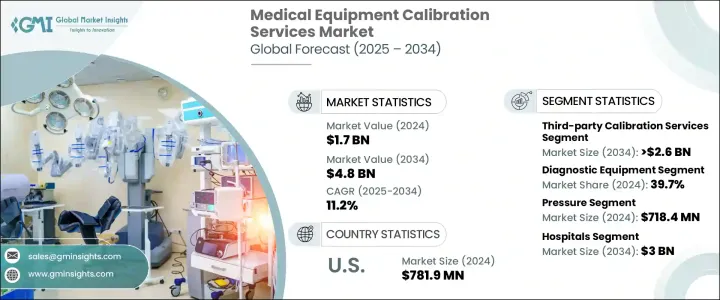
세계의 의료장비 교정 서비스 시장 규모는 2024년에 17억 달러로 평가되었고, CAGR 11.2%로 성장할 전망이며, 2034년에는 48억 달러에 이를 것으로 예측되고 있습니다.
이 배경에는 의료장비의 정확성에 대한 중요한 요구와 진화하는 규제 기준을 준수하는 헬스케어 제공업체에 대한 압력의 고조가 있습니다. 고성능 진단기기와 치료기기의 사용이 증가함에 따라 병원이나 진료소에서는 신뢰성을 유지하고 잠재적인 오류를 줄이기 위해 교정을 우선시하도록 되어 있습니다. 의료장비의 정확한 성능을 확보하는 것은 환자의 회귀를 향상시키고 규제 당국이 실시하는 품질 벤치마크를 충족시키는 데 직접 기여합니다.

만성질환의 이환율이 세계적으로 상승하고 있는 가운데 장기 케어에 사용되는 적절하게 교정된 장비에 대한 수요도 급증하고 있습니다. 환자 모니터링이나 질병 관리에 사용되는 기기는 성능을 발휘해야 하기 때문에 교정 서비스는 진단 오류 경감에 필수적입니다. 부적절한 교정은 환자의 안전성을 해칠 수 있기 때문에 시의적절한 유지보수는 기술적인 필요성뿐만 아니라 전략적인 헬스케어의 필수사항이 되기도 합니다. 게다가 화상 진단 시스템 및 모니터링 시스템의 진보로, 기능을 유지하고 안전성을 확보하기 위해서 보다 고도의 교정 프로세스가 필요해, 전문 서비스의 가치를 높이고 있습니다.
| 시장 범위 | |
|---|---|
| 시작 연도 | 2024년 |
| 예측 연도 | 2025-2034년 |
| 시작 금액 | 17억 달러 |
| 예측 금액 | 48억 달러 |
| CAGR | 11.2% |
서드파티 제공업체는 2034년까지 26억 달러를 창출하였으며, CAGR에 역량이 없는 유연하고 비용 효율적인 솔루션을 제공함으로써 인기를 얻고 있습니다. 12.2%로 성장했습니다. 서드파티 교정 분야는 2034년까지 26억 달러를 창출할 전망이며, CAGR 12.2%로 성장이 예측됩니다. 많은 헬스케어 시설은 외부 벤더와의 제휴를 선호하고 있습니다. 외부 벤더는 폭넓은 기기에 대해 커스터마이즈된 교정을 제공하는 한편, 시설이 규제 기관에 의해 설정된 가이드라인에 계속 준거하는 것을 지원하기 때문입니다. 멀티벤더 아웃소싱 모델을 채택함으로써 헬스케어 시설은 서비스 효율을 높이고 유지보수 업무를 간소화할 수 있습니다.
진단 장비는 2024년에 39.7%에서 가장 큰 점유율을 차지했습니다. 의료용 화상 진단에서 고정밀도 시스템에 대한 의존도의 고조가, 교정 수요를 높이고 있습니다. 진단 현장에서 사용되는 기기는 최적의 기능을 유지하기 위해 빈번하고 정확한 조정이 필요합니다. 특히 의료기술이 복잡해지고 고도의 소프트웨어 및 자동화 기능과 통합됨에 따라 규제 의무화가 교정의 중요성을 더욱 높이고 있습니다.
미국의 의료장비 교정 서비스 시장 규모는 2024년에 7억 8,190만 달러였습니다. 새로운 기기의 빈번한 도입과 확립된 규제 프레임워크에 의해 교정 서비스는 병원, 진단 랩, 연구 기관의 지속적인 임상 업무에 필수적이 되고 있습니다.
Trescal, Fluke Biomedical, Transcat, Tektronix, SIMCO Electronics 등 세계 의료장비 교정 서비스 시장의 주요 기업은 경쟁력을 높이기 위해 몇 가지 전략적 이니셔티브를 추진하고 있습니다. 많은 기업이 인수나 제휴를 통해 지리적 위상을 확대하고 국제적인 품질 기준을 충족하면서 지역 밀착형 서비스를 제공할 수 있도록 하고 있습니다. 각 회사는 AI 기반 교정 기술과 자동 추적 시스템에 투자하여 정확도와 효율을 높이고 있습니다. 번들 메인터넌스 패키지나 24시간 365일 대응의 서비스 계약을 제공하는 것으로, 고객과의 관계를 깊게 해, 서비스 집약형 산업에서의 차별화를 도모하고 있습니다.
The Global Medical Equipment Calibration Services Market was valued at USD 1.7 billion in 2024 and is estimated to grow at a CAGR of 11.2% to reach USD 4.8 billion by 2034, driven by the critical need for accuracy in medical devices and the increasing pressure on healthcare providers to remain compliant with evolving regulatory standards. With greater use of high-performance diagnostic and therapeutic equipment, hospitals and clinics are prioritizing calibration to maintain reliability and reduce potential errors. Ensuring precise performance in medical tools directly contributes to enhancing patient outcomes and meeting quality benchmarks enforced by regulatory authorities.

As the incidence of chronic illnesses continues to rise globally, the demand for properly calibrated devices used in long-term care also surges. Equipment used in patient monitoring and disease management must deliver performance, making calibration services vital in mitigating diagnostic mistakes. Inadequate calibration can compromise patient safety, which makes timely maintenance not only a technical necessity but also a strategic healthcare imperative. Moreover, advances in imaging and monitoring systems require more sophisticated calibration processes to maintain functionality and ensure safety, driving up the value of specialized services.
| Market Scope | |
|---|---|
| Start Year | 2024 |
| Forecast Year | 2025-2034 |
| Start Value | $1.7 Billion |
| Forecast Value | $4.8 Billion |
| CAGR | 11.2% |
Third-party service providers are gaining popularity for offering flexible, cost-effective solutions without in-house capabilities. The third-party calibration segment generated USD 2.6 billion by 2034, growing at a CAGR of 12.2%. Many healthcare facilities prefer to work with external vendors, as they provide customized calibration for a wide range of devices while helping facilities stay compliant with guidelines set by regulatory bodies. By adopting a multi-vendor outsourcing model, healthcare organizations can enhance service efficiency and simplify their maintenance operations.
The diagnostic equipment held the largest share at 39.7% in 2024. Increasing reliance on high-precision systems in medical imaging has elevated the demand for calibration. Equipment used in diagnostic settings requires frequent and precise adjustments to maintain optimal function. Regulatory mandates further reinforce the importance of calibration, especially as medical technology becomes more complex and integrated with advanced software and automation features.
United States Medical Equipment Calibration Services Market generated USD 781.9 million in 2024, as the leadership stems from strict compliance norms and widespread adoption of advanced healthcare technologies. The frequent introduction of new devices and an established regulatory framework make calibration services essential for ongoing clinical operations across hospitals, diagnostic labs, and research institutions.
Key players in the Global Medical Equipment Calibration Services Market-including Trescal, Fluke Biomedical, Transcat, Tektronix, and SIMCO Electronics-are pursuing several strategic initiatives to enhance their competitive edge. Many are expanding their geographic presence through acquisitions and partnerships, enabling them to offer localized services while meeting international quality standards. Companies invest in AI-based calibration technologies and automated tracking systems to improve accuracy and efficiency. By offering bundled maintenance packages and 24/7 service contracts, they aim to deepen customer relationships and differentiate themselves in a service-intensive industry.